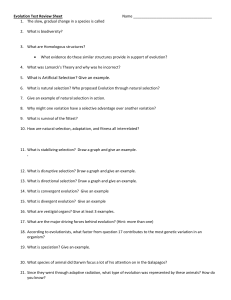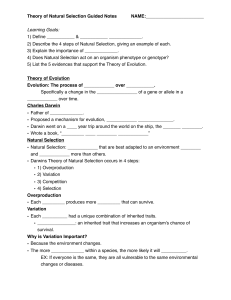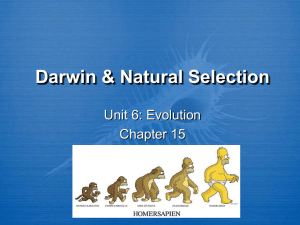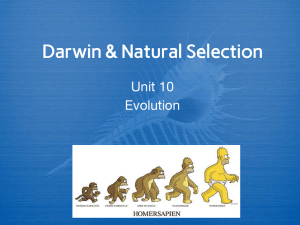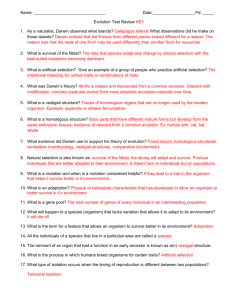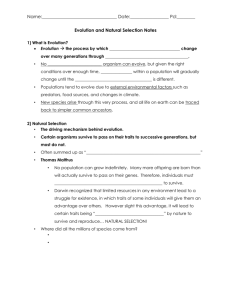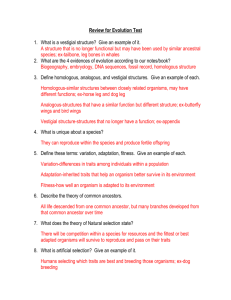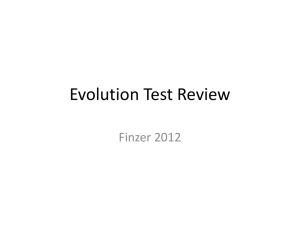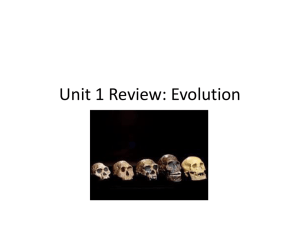Evolution Test Review Sheet
advertisement
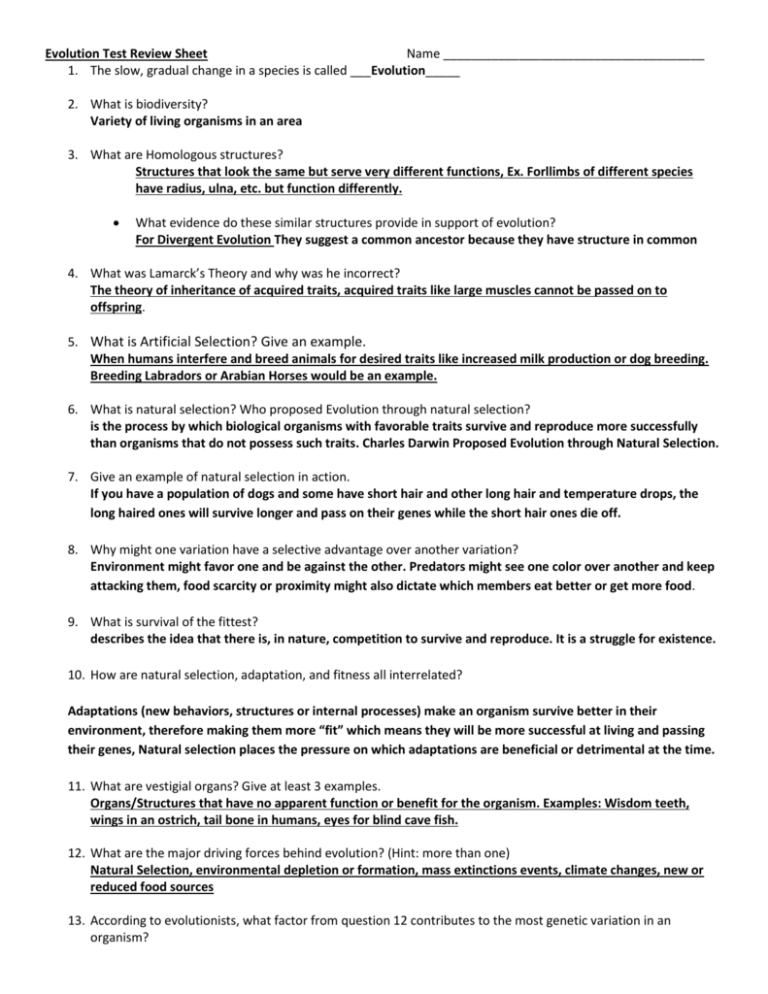
Evolution Test Review Sheet Name ______________________________________ 1. The slow, gradual change in a species is called ___Evolution_____ 2. What is biodiversity? Variety of living organisms in an area 3. What are Homologous structures? Structures that look the same but serve very different functions, Ex. Forllimbs of different species have radius, ulna, etc. but function differently. What evidence do these similar structures provide in support of evolution? For Divergent Evolution They suggest a common ancestor because they have structure in common 4. What was Lamarck’s Theory and why was he incorrect? The theory of inheritance of acquired traits, acquired traits like large muscles cannot be passed on to offspring. 5. What is Artificial Selection? Give an example. When humans interfere and breed animals for desired traits like increased milk production or dog breeding. Breeding Labradors or Arabian Horses would be an example. 6. What is natural selection? Who proposed Evolution through natural selection? is the process by which biological organisms with favorable traits survive and reproduce more successfully than organisms that do not possess such traits. Charles Darwin Proposed Evolution through Natural Selection. 7. Give an example of natural selection in action. If you have a population of dogs and some have short hair and other long hair and temperature drops, the long haired ones will survive longer and pass on their genes while the short hair ones die off. 8. Why might one variation have a selective advantage over another variation? Environment might favor one and be against the other. Predators might see one color over another and keep attacking them, food scarcity or proximity might also dictate which members eat better or get more food. 9. What is survival of the fittest? describes the idea that there is, in nature, competition to survive and reproduce. It is a struggle for existence. 10. How are natural selection, adaptation, and fitness all interrelated? Adaptations (new behaviors, structures or internal processes) make an organism survive better in their environment, therefore making them more “fit” which means they will be more successful at living and passing their genes, Natural selection places the pressure on which adaptations are beneficial or detrimental at the time. 11. What are vestigial organs? Give at least 3 examples. Organs/Structures that have no apparent function or benefit for the organism. Examples: Wisdom teeth, wings in an ostrich, tail bone in humans, eyes for blind cave fish. 12. What are the major driving forces behind evolution? (Hint: more than one) Natural Selection, environmental depletion or formation, mass extinctions events, climate changes, new or reduced food sources 13. According to evolutionists, what factor from question 12 contributes to the most genetic variation in an organism? Mutations. 14. What is speciation? Give an example. Evolution of a new species because of geographic, reproductive isolation, or a change in the number of chromosomes. Ex. Polyploidy in some species of plants, Abert squirrels separated by Grand Canyon. 15. What species of animal did Darwin focus a lot of his attention on in the Galapagos? Finches and tortoises 16. What is a mutation? How does it contribute to adaptation or evolution? Any change in the normal DNA sequence, mutations can give rise to new structures, behaviors, internal processes that might present as an adaptation and make an individual more fit or suited to survive in an environment, they also might cause the death of some and force others to occupy their niche causing adaptive radiation. 17. If you found two fossils in two different layers of sedimentary rock stacked on each other? How would you know which one is older? How can you know for sure? The fossil from the deeper layer would be older because that layer of rock had to be laid there first before the other layer. 18. According to evolutionists, what type of cell is believed to be the first on earth and the one that gave rise to all other life? Prokaryotes (bacteria, single-celled) 19. Two characteristics that help organisms remain “fit” are mimicry and camouflage. a. What is mimicry? Looking similar to other species to ward off predators b. What is camouflage? Blending in with surrounding environment to escape capture or being preyed upon. 20. Natural selection occurs at which level? Individual or population 21. Put the fossils the diagram in order of youngest to oldest. 8, 7, 6, 5, 4, 3, 2, 1 22. What key concept of evolution is represented in the diagram to the right? Homologous Structures and divergent evolution Using your evidence of evolution notes, please answer the following questions using the choices provided. A. Homologous Structure E. Fossil Evidence B. Analogous Structure F. Embryological Evidence C. Vestigial Structure G. Biogeographical Evidence D. Molecular/Biochemical Evidence 23. 24. 25. 26. 27. 28. 29. 30. 31. 32. A modified structure seen among different groups of descendants. _____A______ In the earliest stages of development, a tail and gill slits can be seen in rabbits, fish, birds and humans. ____F___ Exemplified by forelimbs of bats, penguins, lizards, and monkeys. ____A_____ The forelimbs of flightless birds. _____C______ DNA and RNA comparisons may lead to evolutionary trees or cladograms. ____D______ Bird and Butterfly wings have same function but different structures. _____B______ A body structure no longer used but may have had a function in an early ancestor. ____C_______ Structure associated with divergent evolution. _______A_________ Structure associated with convergent evolution. ______B_________ Geographic Isolation would fit into this category. _____G_________
